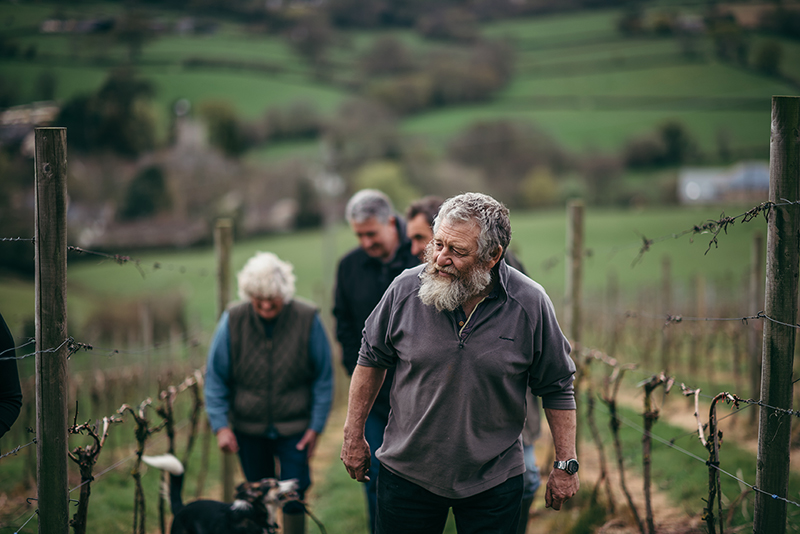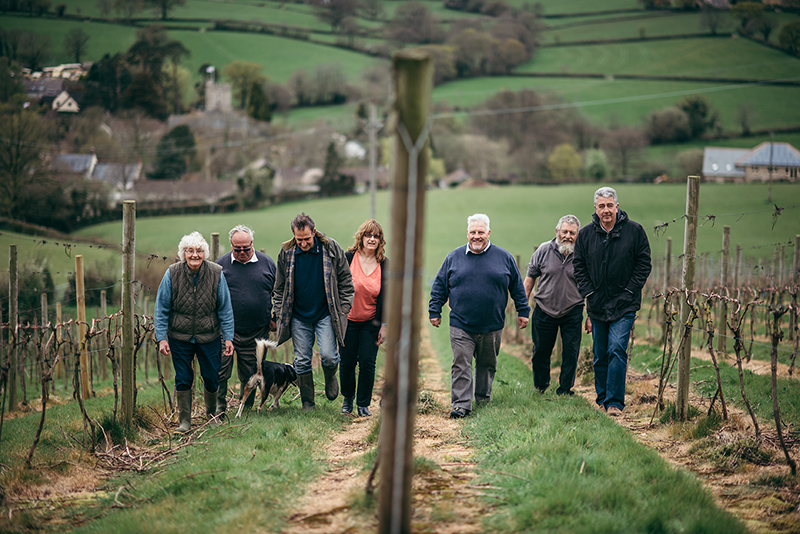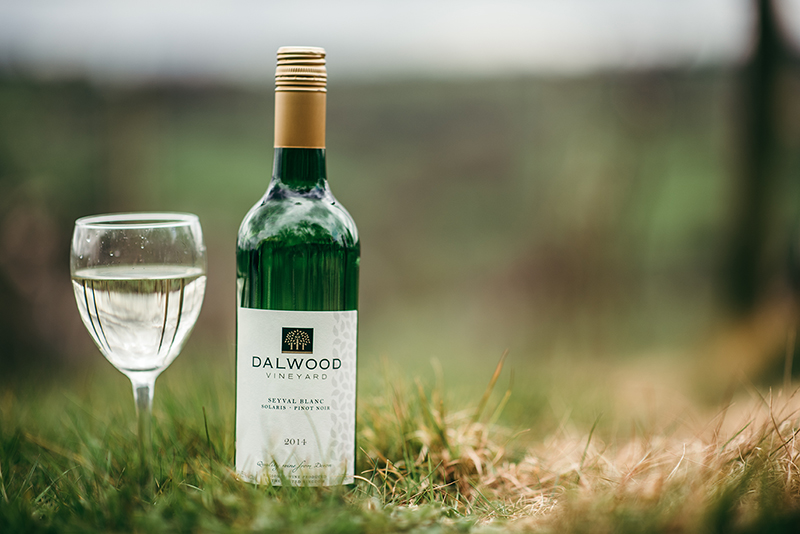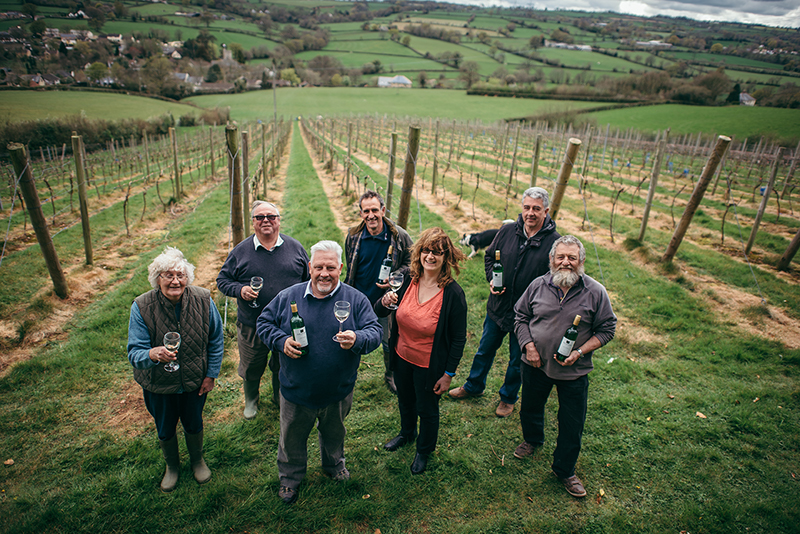Michael Huskins owns and manages Dalwood Vineyard in Devon as part of a co-operative. He talks to Vineyard Magazine about learning on the job and working with your friends.
What’s the story of your vineyard?
We all play skittles at the same pub on a Friday night in our local league. We have about a dozen pints in the Tucker’s Arms, throw some balls, and someone chirped up at about 1am “did you know the Romans grew vines on Danes Hill?” and someone else said “oh we should do that”.
Of course, like all good ideas made at 1am tend to fall by the wayside. Except the following week someone brought up another fact and then before you knew it, five of us were planting a vineyard.
How did you go from drinking at the pub to actually growing grapes?
We have two who are retired, a builder, a market researcher – I am a cattle geneticist. I do have a degree in agriculture but was the only one with any formal education when it comes to working anything to do with the soil or farming. We had an eclectic mix of folk. David was sent to Plumpton on a day release for a year. That was in 2008, in 2009 we planted about 11,000 Seyval, in 2010 we planted the Pinot Noir and the Solaris – and that was that. We were five guys who knew nothing about winemaking or vineyards.

How does sharing the work between your co-op go?
We’ve had some monumental fallouts. For pruning we each get 7,000 vines and away we go. We all rotate the jobs – I look after the vineyard management, all the sales, social media, but I also do all of the spraying and a lot of the actual vine management. Jon does all the trellis work and the mowing, and the other three tend to just float about. When jobs need doing, like winter pruning or bud rubbing, we always get a section each. Every year we stick to our bunch of vines and then the following year we swap round again. No one vine gets the same treatment each year.
How did your first wine turn out?
Our first wine was made in 2013, which was 100% Seyval. Then we made our first commercial mistake in 2014. In 2013 we put it all into sparkling, and then in 2014 we decided to make all still because we already had 1,600 bottles of sparkling. Then in 2015 they all came on together, the ’13 had done 18 months on the lees and I was itching to sell something. As a joke, one of us put it into Decanter and it won a bronze medal – of course we’d sold out in four months. We were all out of sparkling as we’d put all of 2014 into still and had to wait until the 2017 to have more to sell.

What do you think sets your wine apart?
I will be bias but our wines are slightly different to everyone else. Their sparkling tends to be the three nobles and we’re 70% Seyval and 30% Pinot Noir – but we’ve only got 4g Dosage on it so the texture is superb and it’s got a lovely grip to it. It’s more fruit driven than some of the really autolytic sparking wines. There aren’t a lot out there that are comparable.
Our still is 50% Solaris, 30% Madeleine Angevine and 20% Seyval Blanc. This is the first time we’ve used Seyval Blance because 2018 was so warm and the grapes got so much riper, I was afraid it was going to be a little bit flabby. We green harvested a little bit of Seyval and put that in with it to get a bit of acidity. No one else is doing that blend so it’s totally different.
What’s been the best choice you made in the vineyard?
Not having a one trick pony. No matter what year, it’s very unlikely all four varieties will be a disaster. In 2018 what we did was completely different and we’ve not done it since, we decided to make a Rosé Brut because the Pinot Noir was great and we made more still. That really worked because we were flexible and open-minded enough.

How did you end up selling and managing?
Some of the others really don’t want to deal with the public, which is difficult if you’re trying to sell a product. Where my day job involves selling, even though I’m a geneticist it’s for a cattle breading company so requires selling all over the world.
Are you quite technical in your approach to winemaking?
I wouldn’t say we were maverick or technical, I think because we’ve got three varieties and the Pinot, there’s always going to be a year that one shines brighter than the others. We planted the four varieties, some of them were mistakes. We wanted to be a little different from everybody else, and I think I would never drop Seyval out of our sparkling but we’ve had to learn to work with it. It is more acidic, fruit driven and needs longer on the lees than we first gave it. Once we put Pinot Noir with it, it was like putting laces on shoes. Because we’re small and we only make 6-7,000 bottles, we can mess about. It’s a lot of hard work but it’s not going to break us if it doesn’t work. It means we can be flexible and alter what we want to do.

Are your grapes actually planted on the Roman site?
There’s some ancedotal evidence. The Romans were in this part, the Fosse Way starts about five miles from us and there’s a Roman road about a mile from us, so we do know that this was one of the first parts they colonised. There is evidence – how accurate it actually happened on that site, I’m not sure, but I wouldn’t want the truth to get in the way of a good story. I do tell wine tours that it’s all anecdotal.
What’s your best lesson learnt?
Always make a still. Firstly, because it gives you turnover of cash and you can sell something at £12 – £15 to pay some bills to then make your flagship sparkling. We’re 10 years in, we haven’t had to subsidise the vineyard for three and we all had some money back last year, so it is standing on its own two feet.
What equipment couldn’t you live without?
Bearing in mind we’re in Devon, we get about 50cm of rain a year, our Lipco sprayer is fantastic. We have a little Gator that’s been an absolute Godsend, that we bought second hand from a golf course. We’re very limited in what we have but if I had to choose one thing it would have to be the sprayer.






